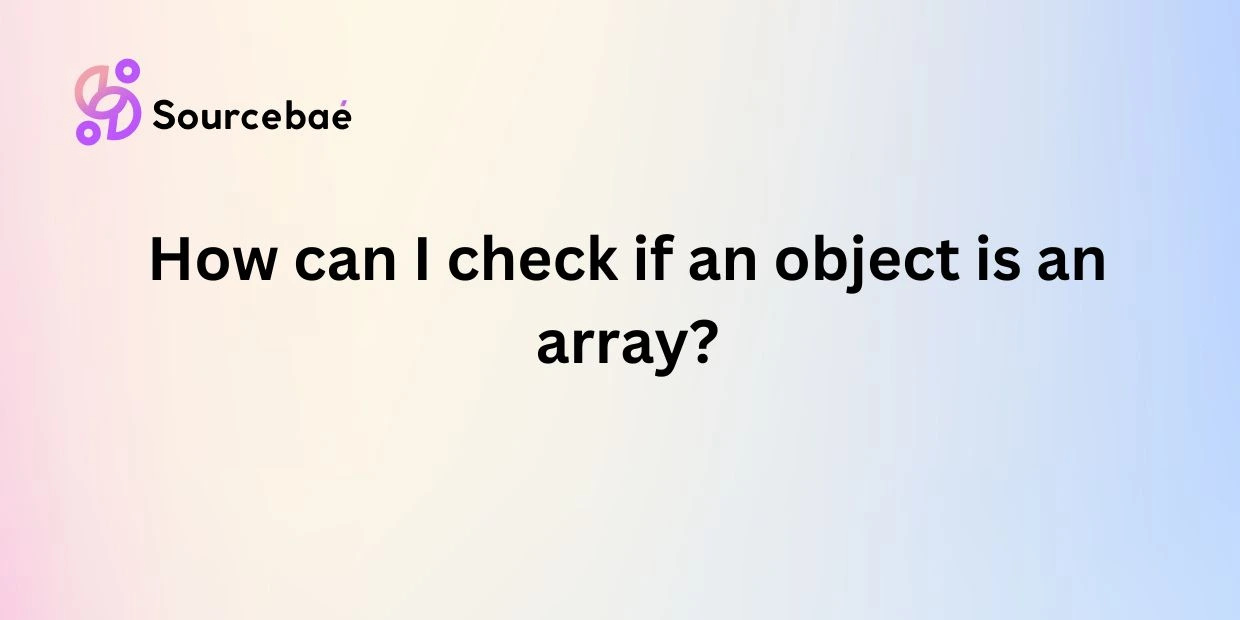Introduction
In the world of programming, it is essential to be able to accurately identify the data type of objects to ensure the proper handling and manipulation of data. One common scenario that programmers often encounter is the need to determine whether an object is an array or not. In this blog post, we will explore the importance of knowing the data type of an object, specifically focusing on arrays, and provide a detailed overview of various methods to check if an object is an array.
Methods to Check if an Object is an Array
Using the type of Operator
The typeof operator is a unary operator in JavaScript that returns a string indicating the data type of the operand. When used to check if an object is an array, the typeof operator will return "object". However, it does not differentiate between different types of objects, such as arrays, functions, or objects.
const myArray = [1, 2, 3];
console.log(typeof myArray === 'object'); // true
Using the Array.isArray() Method
The Array.isArray() method is a built-in method in JavaScript that returns true if the specified value is an array; otherwise, it returns false. This method is specifically designed to check if an object is an array, making it a more reliable option compared to the typeof operator.
The modern, recommended approach is to use the built-in Array.isArray() method:
const fruits = ["apple", "banana", "cherry"];
console.log(Array.isArray(fruits)); // true
const notAnArray = { 0: "apple", 1: "banana", length: 2 };
console.log(Array.isArray(notAnArray)); // falseArray.isArray(value) returns true if value is an array, and false otherwise. This is often the simplest way to perform the check, and it works correctly for iframes and multiple execution contexts—a scenario where other solutions might fail.
Browser support:
Array.isArray()is widely supported in modern browsers and Node.js. For really old environments (like IE8), you’d need a polyfill, but most current projects won’t have that issue.
Using the instance of operator
The instanceof operator is another way to check if an object is an array in JavaScript. It tests whether the prototype property of a constructor appears anywhere in the prototype chain of the object. When used with arrays, the instanceof operator will return true if the object is an instance of the Array constructor.
An older way to check if an object is an array is by using the instanceof operator:
const fruits = ["apple", "banana", "cherry"];
console.log(fruits instanceof Array); // true
const notAnArray = { 0: "apple", 1: "banana", length: 2 };
console.log(notAnArray instanceof Array); // falseWhile this works in many scenarios, it can give misleading results in certain edge cases—particularly when dealing with arrays created in different frames or windows. For example, if you pass an array from an iframe into the main window’s JavaScript, instanceof Array in the main window might fail. This is because each frame has its own global object and constructor references.
When to use: If your environment won’t be dealing with arrays from different global contexts (like iframes),
instanceofis quick and generally fine. Otherwise, preferArray.isArray().
3. Object.prototype.toString.call()
Before Array.isArray() was introduced, developers often used the low-level [object Array] tag check:
function isArray(value) {
return Object.prototype.toString.call(value) === "[object Array]";
}
const fruits = ["apple", "banana", "cherry"];
console.log(isArray(fruits)); // true
const notAnArray = { 0: "apple", 1: "banana", length: 2 };
console.log(isArray(notAnArray)); // falseThis approach is reliable across frames because it directly examines the internal [[Class]] property. However, writing this boilerplate repeatedly can be tedious, and Array.isArray() neatly encapsulates this logic for you.
Note: For older browsers without
Array.isArray(), you might still see this approach. But if you’re targeting modern browsers or Node.js, this isn’t strictly necessary anymore.
Example Use Case
Let’s consider a function that takes an argument and handles it differently if it’s an array or not:
function handleInput(data) {
if (Array.isArray(data)) {
console.log("Data is an array with length:", data.length);
// Process array elements, for example:
data.forEach((item, index) => {
console.log(`Item at index ${index}:`, item);
});
} else {
console.log("Data is NOT an array:", data);
// Handle non-array case
}
}
handleInput(["apple", "banana", "cherry"]);
// Output:
// Data is an array with length: 3
// Item at index 0: apple
// Item at index 1: banana
// Item at index 2: cherry
handleInput({ name: "apple", color: "red" });
// Output:
// Data is NOT an array: { name: 'apple', color: 'red' }Using Array.isArray() ensures that your code behaves predictably in all modern JavaScript environments.
Frequently Asked Questions (FAQs)
How can I check if an object is an array in JavaScript?
To check if an object is an array in JavaScript, you can use methods like the typeof operator, Array.isArray(), or the instanceof operator. Each method has its own advantages and may be more suitable depending on the specific requirements of your code.
What is the difference between using typeof, Array.isArray(), and instanceof to check if an object is an array?
The main difference between using typeof, Array.isArray(), and instanceof to check if an object is an array lies in their functionality and reliability. While the typeof operator may not always accurately identify arrays, Array.isArray() and instanceof are specifically designed for this purpose, offering more reliable results.
Can I use other methods to check if an object is an array?
In addition to the methods mentioned in this blog post, there may be other ways to check if an object is an array in JavaScript. However, it is important to consider the reliability and efficiency of the method in accurately identifying arrays to ensure proper data handling in your code.
How can I handle nested arrays when checking if an object is an array?
When dealing with nested arrays, it is essential to iterate through the elements of the array recursively to check if each element is an array. By implementing a recursive function to traverse nested arrays, you can accurately identify if an object is an array, even if it contains nested arrays within it.
Conclusion
In conclusion, accurately identifying the data type of an object, such as an array, is crucial in programming to ensure proper data manipulation and handling. By utilizing methods like the typeof operator, Array.isArray(), and the instanceof operator, programmers can effectively check if an object is an array and make informed decisions in their code. I encourage readers to practice using these methods in their coding projects to enhance their programming skills and optimize their code for improved efficiency.






